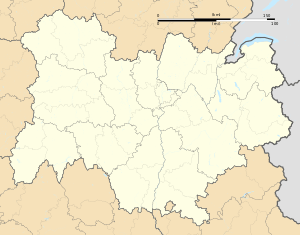Roanne
Roanne (French pronunciation: [ʁɔan] ; Rouana in Arpitan) is a commune in the Loire department in central France.
Roanne | |
|---|---|
Subprefecture and commune | |
Musée Déchelette | |
.svg.png) Coat of arms | |
Location of Roanne 
| |
 Roanne  Roanne | |
| Coordinates: 46°02′12″N 4°04′08″E | |
| Country | France |
| Region | Auvergne-Rhône-Alpes |
| Department | Loire |
| Arrondissement | Roanne |
| Canton | Roanne-1 and 2 |
| Intercommunality | Grand Roanne |
| Government | |
| • Mayor (2014–2020) | Yves Nicolin (LR) |
| Area 1 | 16.12 km2 (6.22 sq mi) |
| Population (2017-01-01)[1] | 34,366 |
| • Density | 2,100/km2 (5,500/sq mi) |
| Time zone | UTC+01:00 (CET) |
| • Summer (DST) | UTC+02:00 (CEST) |
| INSEE/Postal code | 42187 /42300 |
| Elevation | 257–304 m (843–997 ft) (avg. 279 m or 915 ft) |
| 1 French Land Register data, which excludes lakes, ponds, glaciers > 1 km2 (0.386 sq mi or 247 acres) and river estuaries. | |
It is located 90 km (56 mi) northwest of Lyon on the Loire River. It has an important Museum, the Musée des Beaux-arts et d'Archéologie Joseph-Déchelette (French), with many Egyptian artifacts.
Economy
Roanne is known for gastronomy (largely because of the famous Troisgros family), textiles, agriculture and manufacturing tanks.
History

The toponomy is Gaulish, Rod-Onna ("flowing water") which became Rodumna, then Rouhanne and Roanne. The town was sited at a strategic point, the head of navigation on the Loire, below its narrow gorges. As a trans-shipping point, its importance declined with the collapse of long-distance trade after the fourth century. In the twelfth century, the site passed to the comte du Forez, under whose care it began to recover. An overland route led to Lyon and the Rhône, thus Roanne developed as a transshipping point between Paris and the Mediterranean in early modern France, when waterways were at least as important as roads.
The renewed navigation on the Loire encouraged the export of local products— wines, including casks of Beaujolais that had been shipped overland, ceramics, textiles—and after 1785, coal from Saint-Étienne, which had formerly been onloaded upstream at Saint-Rambert, since river improvements at the beginning of the century. Sturdy goods were rafted downriver on sapinières that were dismantled after use. Half the population of seventeenth and eighteenth-century Roanne depended in some way on this transportation economy: merchants and factors, carriers, carpenters and coopers, master-boatmen and their journeymen and oarsmen, and waterfront laborers (Braudel p360f).
Roanne was one of the first towns served by railroad, with the opening, 15 March 1833, of the terminal on the right bank at the port of Varennes of the third line, from Andrézieux. Following came the opening of the canal from Roanne to Digoin (1838), which placed the city in the forefront of the French Industrial Revolution.
In 1917 the arsenal was established at Roanne, and from 1940 a new industry developed, producing rayon and other new fibers. In the post-industrial phase that set in during the 1970s, Roanne struggled to find new industry and attract tourism.
The 18th-century actor, playwright and revolutionary Antoine Dorfeuille (1754–1795) was murdered in Roanne.
Population
| Year | Pop. | ±% |
|---|---|---|
| 1793 | 8,500 | — |
| 1806 | 7,270 | −14.5% |
| 1821 | 8,370 | +15.1% |
| 1831 | 9,260 | +10.6% |
| 1841 | 11,330 | +22.4% |
| 1851 | 13,397 | +18.2% |
| 1861 | 17,398 | +29.9% |
| 1872 | 20,037 | +15.2% |
| 1881 | 25,425 | +26.9% |
| 1891 | 31,380 | +23.4% |
| 1901 | 34,901 | +11.2% |
| 1911 | 36,697 | +5.1% |
| 1921 | 37,752 | +2.9% |
| 1931 | 40,502 | +7.3% |
| 1946 | 44,518 | +9.9% |
| 1954 | 46,501 | +4.5% |
| 1962 | 51,731 | +11.2% |
| 1968 | 63,381 | +22.5% |
| 1975 | 55,195 | −12.9% |
| 1982 | 48,705 | −11.8% |
| 1990 | 41,756 | −14.3% |
| 2011 | 36,147 | −13.4% |
| 2016 | 34,685 | −4.0% |
Sports
The city is home to Chorale Roanne Basket, two-time champion of France's top basketball league LNB Pro A. The team plays its home games at the Halle André Vacheresse.
Personalities
Roanne was the birthplace of:
- Édouard Carpentier, (1926-2010) professional wrestler
- Laurent Chabry (1855-1894), biologist who worked in the flying mechanisms of birds and insects
- Jean-Baptiste Nompère de Champagny (1756–1834) was a French politician
- Joseph Déchelette (1862-1914), archaeologist
- Henri Dentz (1881-1945), French Army officer and collaborator
- Pierre Étaix (born 1928), film director
- Jean-Pierre Jeunet (born 1953), film director
- René Leriche (1870–1955), surgeon
- David Ramseyer, basketball player
Twin towns - sister cities
Roanne is twinned with:[2]






References
- "Populations légales 2017". INSEE. Retrieved 6 January 2020.
- "Villes jumelées". aggloroanne.fr (in French). Roanne. Retrieved 2019-11-20.
Sources
- Braudel, Fernand, 1982. The Wheels of Commerce, vol. II of Civilization and Capitalism p. 360.